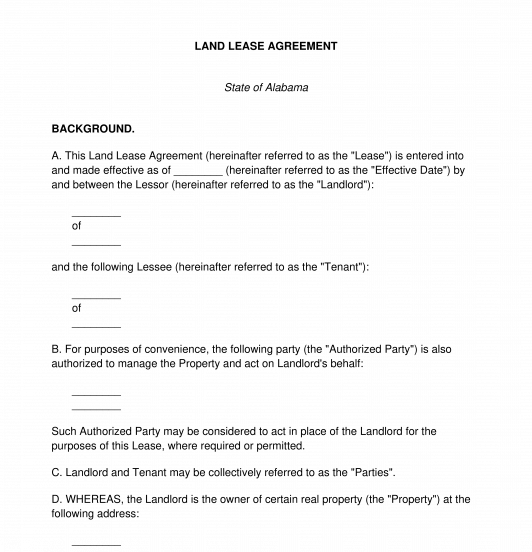 09/30/2025
09/30/2025

Answer a few questions and your document is created automatically.

Your document is ready! You will receive it in Word and PDF formats. You will be able to modify it.

 09/30/2025
09/30/2025
 Word and PDF
Word and PDF
 10 to 14 pages
10 to 14 pages



A Land Lease Agreement is a document used by the owner of a vacant piece of property, known as the landlord, and an individual or entity who wants to occupy the land and develop or improve it, known as the tenant. The lease is for the right to occupy real estate comprised of only dirt and soil, so the land can be used by the tenant for multiple uses ranging from agricultural to residential or commercial purposes. Agricultural land leases can include the use of land as a farm for crops, an orchard for trees, a ranch for hunting wild game and forest animals on the premises, or as a pasture for grazing animals like cattle, goats, and sheep. Commercial land leases can vary from the right to install a billboard, build a telecommunications tower to be used for wireless cell phone reception, open a chain restaurant, or develop a large multi-story hotel complex. Residential land leases can include a spot to park a trailer in a trailer park or the right to construct a small cabin in the woods.
Individuals who purchase, inherit, or otherwise own undeveloped land in either urban or rural settings may benefit from a Land Lease if they want to generate some passive income without the hassle of personally investing the capital, labor, or time needed to build structures and start an independent venture. In rural communities, this sort of tenant farming is common for agricultural or hunting purposes. In these situations, a tenant may have tools or livestock and enough funds to pay for the right to use land, but lack the capital to purchase their own parcel of land outright. In addition to raising livestock or crops, landowners with large properties in the countryside may profit from leasing their property to a hunter or hunting association during hunting season. In addition to earning a seasonal income, a Land Lease to hunt on uninhabited land may prevent crop damage and disease in livestock by managing wildlife in the area. In urban settings, a Land Lease is often used by large chain stores that would like to take advantage of a prime location without having to pay large sums of money for the underlying real estate. By using a Land Lease, the tenant has access to land that they would not otherwise have had access to and the landlord generates steady income with the potential of inheriting any structures or improvements built on the land when the lease ends.
This Agreement is specifically for leasing land that is undeveloped and not for the purpose of renting structures on the land. A Farm Lease Agreement can be used to lease a developed farm that has crops or livestock, a Commercial Lease Agreement can be used to lease a developed commercial property, and a Residential Lease Agreement can be used to lease a developed residential property.
How to use this document
This document includes all of the information necessary to create a thorough and comprehensive Land Lease Agreement. This Agreement can be created by either the landlord or the tenant but its terms must be agreed to and signed by both parties. The document includes various options to tailor the Agreement to meet the parties' needs. The Agreement allows the Parties to specify the following important details that will guide their landlord/tenant relationship:
After inputting the required information, the Agreement is printed out and signed by both Parties, and then kept on file by both Parties for the duration of the Agreement as well as for a reasonable period of time thereafter.
Applicable law
All Lease Agreements in the United States are generally subject to the laws of individual states.
The Environmental Protection Agency governs the disclosure of lead-based paint warnings in all rentals in the States. Distinct from that, however, required disclosures and lease terms will be based on the laws of the state, and sometimes county, where you live.
How to modify the template
You fill out a form. The document is created before your eyes as you respond to the questions.
At the end, you receive it in Word and PDF formats. You can modify it and reuse it.
Land Lease Agreement - FREE - Template - Word & PDF
Country: United States